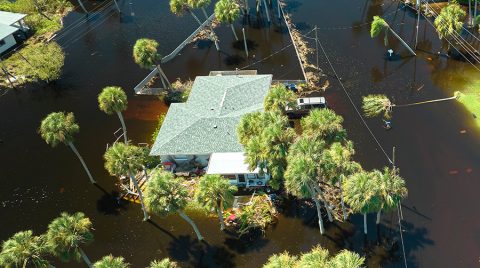-
Property & Casualty
Property & Casualty Overview

Property & Casualty
We offer a full range of reinsurance products and the expertise of our talented reinsurance team.
Expertise
Publication
Florida Property Tort Reforms – Evolving Conditions
Publication
Is Human Trafficking the Next Big Liability Exposure for Insurers?
Publication
When Likes Turn to Lawsuits – Social Media Addiction and the Insurance Fallout
Publication
Generative Artificial Intelligence and Its Implications for Weather and Climate Risk Management in Insurance
Publication
Engineered Stone – A Real Emergence of Silicosis
Publication
Who’s Really Behind That Lawsuit? – Claims Handling Challenges From Third-Party Litigation Funding -
Life & Health
Life & Health Overview

Life & Health
We offer a full range of reinsurance products and the expertise of our talented reinsurance team.

Publication
Understanding Physician Contracts When Underwriting Disability Insurance
Publication
Voice Analytics – Insurance Industry Applications [Webinar]
Publication
GLP-1 Receptor Agonists – From Evolution to Revolution U.S. Industry Events
U.S. Industry Events
Publication
Always On: Understanding New Age Addictions and Their Implications for Disability Insurance
Publication
Dying Gracefully – Legal, Ethical, and Insurance Perspectives on Medical Assistance in Dying -
Knowledge Center
Knowledge Center Overview

Knowledge Center
Our global experts share their insights on insurance industry topics.
Trending Topics -
About Us
About Us OverviewCorporate Information

Meet Gen Re
Gen Re delivers reinsurance solutions to the Life & Health and Property & Casualty insurance industries.
- Careers Careers
Generative Artificial Intelligence and Its Implications for Weather and Climate Risk Management in Insurance

September 15, 2025
Frank Schmid
English
Deutsch
Weather and climate hazards remain among the most material sources of uncertainty for insurers and reinsurers, shaping loss experience across property, agricultural, marine, and energy lines, including associated business-interruption coverages. Tropical cyclones, floods, hail, drought, and wildfires generate both frequent attritional losses and rare, severe tail events that strain capital, challenge catastrophe models, and test the adequacy of reinsurance protections. In this setting, the accuracy, timeliness, and probabilistic quality of forecasts are not merely scientific concerns; they are operational inputs to underwriting selection, claims-surge management, reinsurance structuring, and regulatory capital.
From Physics-Based Numerical Weather Prediction to Generative AI
The industry has long depended on numerical weather prediction (NWP), which integrates the governing equations of atmospheric motion and thermodynamics on computational grids. Skill has improved markedly, yet practical constraints persist. High-resolution deterministic runs and large ensembles are expensive and slow, and latency from initialization to product delivery can limit how quickly exposure, staffing, and hedging can adjust to rapidly evolving events. The premium value of ensembles – quantifying distributions and tails rather than a single trajectory – has often collided with compute budgets and operational deadlines.
Here, generative AI refers to models trained on large archives of weather data – especially reanalyses and, in some cases, operational analyses1 – that learn how atmospheric variables evolve together. At runtime, they infer future states from these learned relationships rather than numerically solving the full set of physical equations, enabling skillful forecasts in minutes at much lower computational cost and at resolutions suitable for practical use. Reanalysis datasets – like ERA5, compiled by the Copernicus Climate Change Service (C3S) at the European Centre for Medium-Range Weather Forecasts (ECMWF) – provide multi-decade, globally consistent fields that ground the models in variability across scales, including extreme events.2
State of the Art
Among the most influential systems is Google DeepMind’s GraphCast.3 It represents the atmosphere on a spherical graph, passes information between nodes to capture multiscale interactions, and runs autoregressively in six-hour steps to produce forecasts out to 10 days. A peer-reviewed study in Science reported that GraphCast outperformed ECMWF’s high-resolution deterministic model (HRES) on about 90% of 1,380 verification targets while delivering forecasts with very low latency.4 For insurers, this enables rapid, high-skill deterministic guidance on wind, precipitation, and temperature – parameters that directly inform windstorm loss estimation, flood claims triage, and real-time operational monitoring during active events.
Probabilistic modeling has advanced just as quickly. DeepMind’s GenCast5 extends this paradigm to ensembles using diffusion-based generative modeling. In results published in Nature in 2025, GenCast produced global 15‑day ensembles at 0.25° resolution with 12‑hour time steps in around eight minutes, surpassing the skill of ECMWF’s ENS – its operational ensemble system – on most evaluated targets.6 Because loss ratios and capital charges are often driven by tails rather than means, frequent, affordable ensemble updates materially improve tail quantification, facilitating recalibration of parametric triggers, revisions to event-response footprints, and more precise reserving as a catastrophe unfolds.
A wider ecosystem is pushing the field forward. Huawei’s Pangu-Weather, published in Nature in 2023, demonstrated competitive medium-range skill at substantially lower computational cost,7 which matters where access to high-performance computing is constrained. NVIDIA’s FourCastNet family, together with the Earth‑2 platform, combines Fourier-operator8 and transformer-style architectures with GPU (Graphics Processing Unit) acceleration to deliver rapid global forecasts and support very large ensembles.9 Generative AI is also entering climate modeling through hybrid systems such as NeuralGCM.10 These models retain a physics-based core and use machine learning to represent processes that are difficult to resolve directly. They are designed to remain stable from day-to-day weather out to multi-decade simulations, pointing toward a single framework that links near-term hazard forecasts with long-term climate-risk projections.
Microsoft’s Aurora adds a foundation-model approach: a ~1.3‑billion-parameter 3D architecture pretrained on more than one million hours of heterogeneous Earth-system data and then fine-tuned for tasks including high-resolution weather, air quality, ocean waves, and tropical-cyclone track. Peer-reviewed and technical materials report that Aurora matches or exceeds operational baselines across these tasks at orders-of-magnitude lower computational cost, with sub-minute generation of 10‑day high-resolution forecasts using modern GPU acceleration.11
Operational Validation
Perhaps the most consequential endorsement has come from ECMWF. On 25 February 2025, the Centre made its Artificial Intelligence Forecasting System (AIFS) operational for deterministic forecasts, running alongside the traditional physics-based Integrated Forecasting System (IFS).12 On 1 July 2025, ECMWF took the ensemble version of AIFS into operations, delivering products through its standard dissemination and open-data channels.13 Early verification indicated parity or superiority to conventional models on key metrics, including reported gains of up to roughly 20% in tropical-cyclone track forecasts.14 For insurers with coastal exposures, improved track guidance translates into more reliable surge preparation, more accurate event footprints, and tighter interim loss estimates. AI forecasts now flow through ECMWF’s operational and open-data streams—the same channels widely used by third-party modeling and analytics workflows.15
Three Approaches to Weather and Climate Forecasting
Numerical Weather Prediction (NWP) – NWP uses physics-based computer models to simulate the atmosphere and advance conditions forward in time. Its strengths are scientific grounding, mature procedures for ingesting and assimilating observations, and decades of systematic verification. Limitations include substantial computing requirements and slower turnaround, which can constrain update frequency and spatial resolution. Skill is generally strongest from the near term into the medium range – hours to roughly 10 days – with performance varying by region, season, and weather regime.
Ensemble Models – Ensemble forecasting generates many plausible versions of a forecast by perturbing initial conditions, varying model settings, or combining different modeling systems, including modern AI members. Rather than a single answer, ensembles provide a distribution of outcomes with associated probabilities, enabling clearer statements about uncertainty and extremes. To remain reliable, ensembles should be calibrated and bias-corrected so that their spread reflects observed uncertainty. Practical considerations include larger data volumes, ongoing quality control, and clear communication of probabilistic results.
Differentiable General Circulation Models (dGCMs) – dGCMs combine a traditional physics core with machine-learning components in a framework that can be tuned more directly using data. The aim is to preserve physical structure while improving elements that are difficult to represent explicitly. In principle, this supports consistent performance from day-to-day weather prediction through multi-decade climate simulations. Current priorities include demonstrating reliability in extreme events, limiting slow drift over long runs, managing regional biases, and maintaining transparency about the behavior of learned components.
Implications, Adoption, and Integration
The implications for underwriting, reinsurance, and capital are immediate. Faster and cheaper ensembles support more frequent loss intelligence during events, allowing claims organizations to pre-position resources and secure temporary housing and repair capacity with better lead time. Underwriters can refresh spatial risk scores intra-day as a storm tracks or rainfall envelopes shift, improving exposure management and enabling real-time adjustments to binding authority or aggregation limits.
Reinsurance teams can run scenario trees with materially larger samples, refining layer attachments and reinstatement structures as uncertainty collapses. Capital modeling benefits from better characterization of distribution tails under Solvency II16 and NAIC RBC17 regimes, particularly when event sets are resampled or conditioned on updated dynamical guidance. When combined with well-calibrated vulnerability and financial modules, improvements at the forecast layer yield more stable PMLs (Probable Maximum Loss), tighter AAL (Average Annual Loss) confidence intervals, and sharper interim ranges for boards, investors, and regulators.
Adoption requires rigor. Independent assessments show that while AI weather-prediction models now rival or exceed top physics-based systems on tropical-cyclone track forecasts, intensity – especially in the first 24 hours and during rapid intensification – remains more challenging, with a tendency toward underestimation that can reflect training-data and resolution limits.18 ECMWF’s AIFS notes likewise indicate that small-scale structures can be smoothed and that bias handling for precipitation and other fields remains an active area of development.19 Before model outputs inform high-stakes financial decisions, calibration against local climatology, regime-aware post-processing, and cross-model blending should be applied, and results documented against consistent verification standards.
Integration should prioritize end-to-end consistency and low latency. Meteorological fields should be converted into hazard surfaces at the same resolution as exposure geocoding, then linked to current vulnerability curves and policy terms. Because modern AI systems can refresh ensembles multiple times per day, stream-based assimilation into live catastrophe views is preferable to once-a-day batch updates. Data governance deserves equal attention: model-risk documentation that tracks versions, training-data vintages, and post-processing choices should be maintained for auditability, and clear change-management procedures should be in place. The goal is to ensure that forecast-layer gains carry through to portfolio metrics and capital calculations with minimal delay and without loss of fidelity.
Outlook
Generative AI will not displace physics overnight. Physics-based systems remain essential for data assimilation, out-of-distribution scenarios, and physically grounded validation. What is changing is the economics and cadence of forecasting: data-driven models deliver lower latency and cost at useful resolutions, making frequent updates and large ensembles feasible in daily operations.
The most effective path forward is complementary use. Physics anchors forecasts in conservation laws and long verification records, while AI provides rapid emulation, bias correction, downscaling, and large probabilistic samples. In practice this means AI post-processing of deterministic output, AI‑augmented ensemble perturbations, learned parameterizations within physical models, and targeted surrogates for the most computationally intensive steps. Progress should be guided by disciplined verification and clear governance. Deterministic and probabilistic skill should be tracked with established scores, models and datasets should be versioned, and known biases and calibration procedures should be documented. The result is a broader, faster toolkit—richer probabilistic guidance linked across weather and climate horizons—deployed with transparent calibration and oversight.
- Reanalyses are retrospective reconstructions of past weather created with a single, fixed model, and assimilation system applied consistently to the full historical archive (often including observations unavailable in real time). They aim for temporal homogeneity and stability rather than immediacy; latency is weeks to months. Operational analyses are the real-time “best estimate” atmospheric states produced by a forecasting center’s data-assimilation cycle to initialize today’s forecasts. The model and assimilation system evolve with frequent upgrades, so the record is not uniform over time; latency is hours.
- See Hans Hersbach and Dick Dee, “ERA5 reanalysis is in production,” ECMWF Newsletter No. 147, Spring 2016, https://www.ecmwf.int/en/newsletter/147/news/era5-reanalysis-production.
- See Remi Lam, “GraphCast: AI model for faster and more accurate global weather forecasting,” Google Deep Mind, November 14, 2023, https://deepmind.google/discover/blog/graphcast-ai-model-for-faster-and-more-accurate-global-weather-forecasting/.
- See Remi Lam, Alvaro Sanchez-Gonzalez, Matthew Willson, Peter Wirnsberger, Meire Fortunato, Ferran Alet, Suman Ravuri, Timo Ewalds, Zach Eaton-Rosen, Weihua Hu, Alexander Merose, Stephan Hoyer, George Holland, Oriol Vinyals, Jacklynn Stott, Alexander Pritzel, Shakir Mohamed, and Peter Battaglia, “Learning skillful medium-range global weather forecasting,” Science Vol. 382, No. 6677, November 14, 2023, https://www.science.org/doi/10.1126/science.adi2336.
- See Ilan Price and Matthew Wilson, “GenCast predicts weather and the risks of extreme conditions with state-of-the-art accuracy,” Google Deep Mind, December 4, 2024, https://deepmind.google/discover/blog/gencast-predicts-weather-and-the-risks-of-extreme-conditions-with-sota-accuracy/. For the technical paper, see Ilan Price, Alvaro Sanchez-Gonzalez, Ferran Alet, Tom R. Andersson, Andrew El‑Kadi, Dominic Masters, Timo Ewalds, Jacklynn Stott, Shakir Mohamed, Peter Battaglia, Remi Lam, and Matthew Willson, “GenCast: Diffusion-based ensemble forecasting for medium-range weather,” arXiv:2312.15796, last revised on May 1, 2024, https://arxiv.org/abs/2312.15796.
- See Ilan Price, Alvaro Sanchez-Gonzalez, Ferran Alet, Tom R. Andersson, Andrew El‑Kadi, Dominic Masters, Timo Ewalds, Jacklynn Stott, Shakir Mohamed, Peter Battaglia, Remi Lam, and Matthew Willson, “Probabilistic weather forecasting with machine learning,” Nature Vol. 637, 84‑90, 2025, https://www.nature.com/articles/s41586-024-08252-9.
- See Kaifeng Bi, Lingxi Xie, Hengheng Zhang, Xin Chen, Xiaotao Gu, and Qi Tian, “Accurate medium-range global weather forecasting with 3D neural networks,” Nature Vol. 619, 533‑538, 2023, https://www.nature.com/articles/s41586-023-06185-3, and “Author Correction: Accurate medium-range global weather forecasting with 3D neural networks,” Nature Vol. 621, E45, 2023, https://www.nature.com/articles/s41586-023-06545-z.
- An Adaptive Fourier Neural Operator (AFNO) is a type of neural network architecture that can efficiently learn complex patterns by transforming data into frequencies, making it useful for modeling intricate spatial or temporal relations in weather forecasting.
- See Jaideep Pathak, Shashank Subramanian, Peter Harrington, Sanjeev Raja, Ashesh Chattopadhyay, Morteza Mardani, Thorsten Kurth, David Hall, Zongyi Li, Kamyar Azizzadenesheli, Pedram Hassanzadeh, Karthik Kashinath, and Animashree Anandkumar, “FourCastNet: A Global Data-driven High-resolution Weather Model using Adaptive Fourier Neural Operators,” arXiv:2202.11214, submitted on February 22 2022, https://arxiv.org/abs/2202.11214.
- See Stephan Hoyer, “Fast, accurate climate modeling with NeuralGCM,” Google Research Blog, July 22, 2024, https://research.google/blog/fast-accurate-climate-modeling-with-neuralgcm/. For details, see Dmitrii Kochkov, Janni Yuval, Ian Langmore, Peter Norgaard, Jamie Smith, Griffin Mooers, Milan Klöwer, James Lottes, Stephan Rasp, Peter Düben, Sam Hatfield, Peter Battaglia, Alvaro Sanchez-Gonzalez, Matthew Willson, Michael P. Brenner, and Stephan Hoyer, “Neural general circulation models for weather and climate,” Nature Vol. 632, 1060‑1066, 2024, https://www.nature.com/articles/s41586-024-07744-y.
- See Wessel Bruinsma, Megan Stanley, Ana Lucic, Richard Turner, and Paris Perdikaris, “Introducing Aurora: The first large-scale foundation model of the atmosphere,” Microsoft Research Blog, June 3, 2024, https://www.microsoft.com/en-us/research/blog/introducing-aurora-the-first-large-scale-foundation-model-of-the-atmosphere/. For details, see Cristian Bodnar, Wessel P. Bruinsma, Ana Lucic, Megan Stanley, Anna Allen, Johannes Brandstetter, Patrick Garvan, Maik Riechert, Jonathan A. Weyn, Haiyu Dong, Jayesh K. Gupta, Kit Thambiratnam, Alexander T. Archibald, Chun-Chieh Wu, Elizabeth Heider, Max Welling, Richard E. Turner, and Paris Perdikaris, “A foundation model for the Earth system,” Nature Vol. 641, 1180‑1187, 2025, https://www.nature.com/articles/s41586-025-09005-y.
- See ECMWF, ECMWF’s AI forecasts become operational, February 25, 2025. https://www.ecmwf.int/en/about/media-centre/news/2025/ecmwfs-ai-forecasts-become-operational.
- See ECMWF, ECMWF’s ensemble AI forecasts become operational, July 1, 2025, https://www.ecmwf.int/en/about/media-centre/news/2025/ecmwfs-ensemble-ai-forecasts-become-operational.
- See ECMWF, ECMWF’s AI forecasts become operational, op.cit.
- See ECMWF, Datasets: Open Data, https://www.ecmwf.int/en/forecasts/datasets/open-data.
- See European Insurance and Occupational Pensions Authority, Directive 138/2009/EC (Solvency II Directive), https://www.eiopa.europa.eu/rulebook/solvency-ii-single-rulebook/directive-1382009ec-solvency-ii-directive_en.
- See National Association of Insurance Commissioners, Risk-Based Capital (RBC) for Insurers Model Act, January 2012, https://content.naic.org/sites/default/files/model-law-312.pdf.
- See Mark DeMaria, James L. Franklin, Galina Chirokova, Jacob Radford, Robert DeMaria, Kate D. Musgrave, and Imme Ebert-Uphoff, “Evaluation of Tropical Cyclone Track and Intensity Forecasts from Artificial Intelligence Weather Prediction (AIWP) Models,” arXiv:2409.06735, submitted on September 8, 2024, https://arxiv.org/abs/2409.06735.
- See ECMWF, Implementation of AIFS Single v1, https://confluence.ecmwf.int/display/FCST/Implementation%2Bof%2BAIFS%2BSingle%2Bv1, last modified on August 1, 2025.





